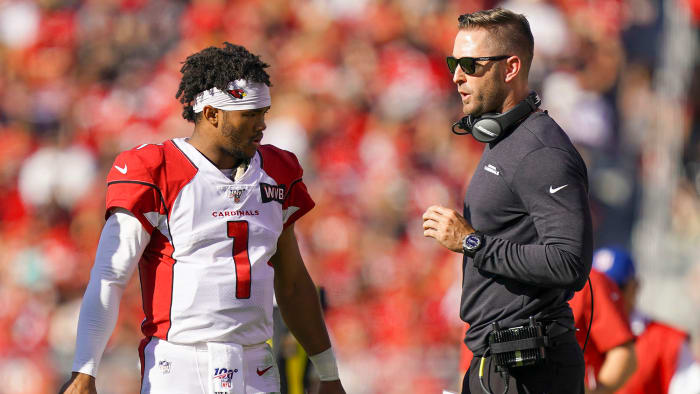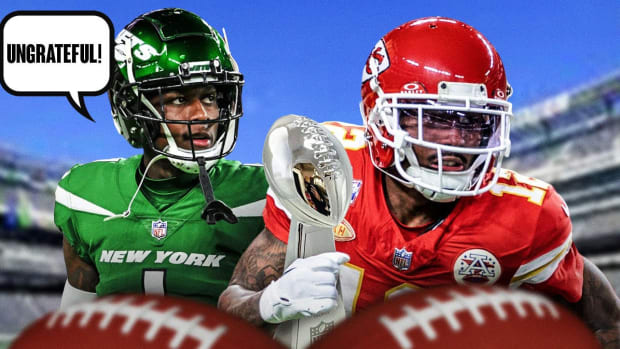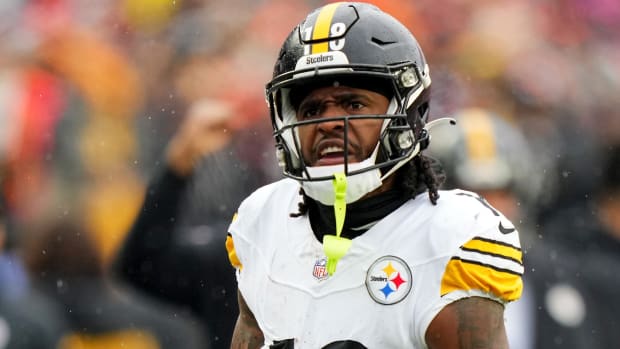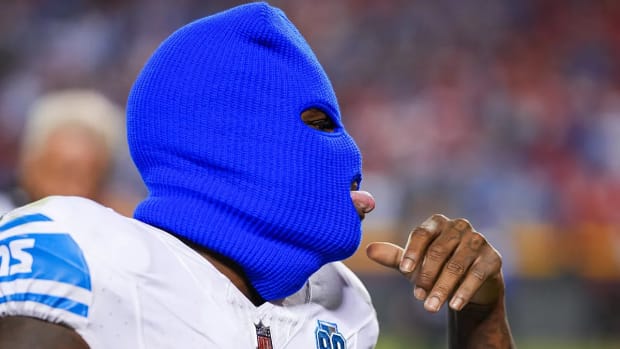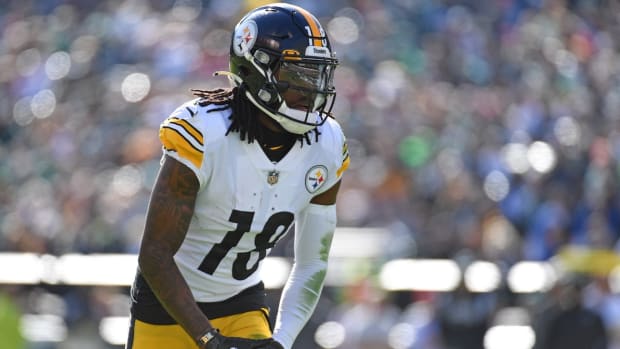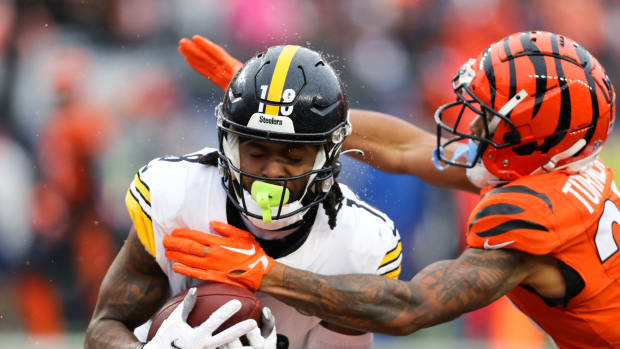Mailbag: Investing in Running Backs, Where Cam Newton Lands and More
Another quiet week in the NFL; another loaded mailbag. Seriously, thanks to all of you for your continued interest in this stuff. Really great to see it, for a lot of reasons. …
From Tyler Schmidt (@teachgeek90): Should teams invest in running backs the way the Jets and Cowboys have done recently or should teams continually look to the draft to find replacements for RBs nearing the end of their rookie contracts?
Tyler, first of all, I absolutely would not invest in a running back the way the Jets did—signing a 27-year-old from somewhere else with five years of tread on his tires (in their case, Le’Veon Bell). And I say that knowing it was an owner-driven move, and even acknowledging that the idea of helping your young quarterback by taking pressure off him is a valid one.
When it’s your own player, like Zeke Elliott was Dallas’s, the dynamic is different. Those in the Cowboy organization told me, as they drafted Elliott, that part of their logic in taking him fourth overall was getting a superstar player in his prime on a rookie deal. And while the idea is solid—tailback is one position where you are likely to get the very best of a guy inside of his first four years—when you hit on that kind of pick, it does get complicated.
Why? Because just as you know an Elliott or a Christian McCaffrey could lose value come Year 5 or 6, they know it too. That, naturally, will amp up a player’s desire to get a deal done, something we saw with Zeke’s holdout last year. And if a player’s as good as he was advertised to be coming out, he’ll naturally become a cornerstone for the team, which could make the choice to reward him academic—especially if a new coach is in place, as is the case in Carolina with McCaffrey, and trying to send the right message to the locker room.
Therein, is the rub. It would have been hard for the Cowboys or Panthers to say no. Elliott won two rushing titles in his first three years in the league and was playing for a team coming off a 13-3 season. McCaffrey rushed for nearly 1,400 yards and caught 116 balls in his third year, and Matt Rhule arrived soon thereafter. So if not take care of these guys, what, exactly, were these teams gonna do?
From Travis Spees (@Travis_Spees): Cam Newton is a starter Week One of the regular season. True or False?
Travis, I’d say false, but that’s largely because I don’t have any clue who’s going to get hurt, or who’s going to disappoint during the first couple weeks of camp. What I would say is that the ship has sailed on the idea of Newton entering camp as someone’s starter, and even the idea that he’d be in a quarterback competition going into late July seems unlikely at this juncture, crazy as all that all sounds.
Yes, Newton was league MVP and a Super Bowl starter less than five years ago. Yes, he just turned 31 in an era in which quarterbacks seem to routinely play into their 40s. But a number of things have conspired to keep him from having a starting job, all of which we’ve been over. Here’s the quick synopsis.
1) The coaching change in Carolina. Matt Rhule’s retooling Carolina was always going to be thorough, making an injured franchise quarterback going into a contract year a tough sell.
2) The circumstances of the offseason. The coronavirus’s impact can’t be overstated. Team doctors couldn’t get hands on Newton, with questions on his right shoulder and left foot lingering. And Newton’s inability to visit face-to-face with decision-makers from other teams made it harder to dispel any other concerns they had.
3) The QB bubble bursting. The glut of cash and draft capital spent on the position over the last few years came to roost, with supply somehow outweighing demand, and players like Newton, Joe Flacco, Jameis Winston and Andy Dalton sitting out there on the market unsigned for weeks. There are a total of three teams in the league that don’t have a QB on their roster who cost them either a first-round pick or a big-money deal.
And that brings us to those three teams—Denver, Jacksonville and New England. All three have a 23-year-old that they want to give a legitimate shot to, and the question then becomes how you’d want to fill out the depth chart behind them. Do you want to create competition? Or support? In each case, the teams have chosen to give a young quarterback support, with veterans who would be more resource than threat to the starter.
Certainly, I think you could argue that if a kid can’t handle competition, then he’s probably not fit to be your long-term starter anyway. But in this case, you can at least understand where a figure like Newton entering the locker room could put a young player in a difficult spot, and may make it harder for the team to get a clean read on his potential. That’s not Newton’s fault. But I think it is making things harder on him.
From Tyler Komis (@TylerKomis): Best rookie in the best situation that no one’s talking about?
Well, there are two that I’ve talked plenty about, that might be a little too obvious for the context of your question: By all accounts, running back Clyde Edwards-Helaire is an insanely strong fit for Andy Reid’s Chiefs offense, and the same can be said for how receiver Brandon Aiyuk should look playing for Kyle Shanahan in San Francisco. And since I know those are too obvious, I’ve got a few sleepers for you, from outside the first two rounds.
Cleveland fourth-round pick Harrison Bryant, a tight end out of Florida Atlantic, is one I absolutely have my eye on. The Browns do have David Njoku, and just signed Austin Hooper, but Kevin Stefanski is going to put in a tight end-friendly offense. And when Baker Mayfield’s been at his best, be it with Mark Andrews at Oklahoma or Njoku his rookie year, he’s effectively used the tight ends in his offense. Bryant’s got real potential there.
Another would be Saahdiq Charles, the left tackle that Washington took at the top of the fourth round out of LSU. On ability alone, some believed that the 20-year-old was a top-five tackle in the class, capable of being a long-term answer for someone on the left side. The issue with Charles was a slew of questions about maturity and responsibility, stemming from a six-game suspension and a slew of positive drug tests he had as a collegian. So he’ll have to grow up fast, but the left tackle spot is wide open in D.C. for the taking.
And on the other side of the ball, one pick that drew a lot of praise from the scouts I talked to was the Saints landing Zack Baun, a versatile linebacker out of Wisconsin, in the third round. There were questions about his ceiling, and his health, and he had the diluted drug-test sample at the combine, but he’s a really good player and should be a strong fit in New Orleans, where DC Dennis Allen will have some fun getting creative in using him.
From Steven Bradley (@Steven_Bradley3): Which one gives the Cowboys best chance to win the Super Bowl ... 35m cap hit for Dak Prescott or 35m combined cap hits for Andy Dalton, Larry Warford, Jamal Adams, Everson Griffin or Jadeveon Clowney, and Logan Ryan?
Steven, it’s an interesting question, the way you put it. And I do understand the point. Is Prescott between 11 and 12 times better than Dalton (using the dollar figures)? No, of course he’s not. And what Dallas COO Stephen Jones has said is correct—there’s very little precedent for quarterbacks on outsized deals winning Super Bowl. In fact, really, of late, there’s no precedent.
Drew Brees became the first player to make over $20 million on a long-term deal eight years ago and, since, no quarterback making that much has won it all—and that’s in an environment where 18 quarterbacks are set to make that much in 2020. Over that eight-year period, from 2012-19, the quarterbacks to win Super Bowls have ranked 16th, 53rd, 12th, 6th, 18th, 28th/47th (Carson Wentz/Nick Foles), 11th and 31st among QBs in cap hit.
Even more interesting, the one guy with a top 10 cap hit was Peyton Manning, who took a pay cut ahead of that season, missed a good chunk of it injured, and was clearly a fraction of what he’d been earlier in his career as a red-hot defense led him to his second ring.
Now, to be sure, some of this is circumstantial. Tom Brady won three of those titles taking less than he could have, and that definitely skews the data set here. But outside of Brady and Manning, you had four teams (Ravens, Seahawks, Eagles and Chiefs) who entered the year with starting quarterbacks on rookie contracts, riding an advantage the Cowboys have had the last three years that allows you to splurge on the kinds of free agents raised in the question here.
And again, there’s merit to all of that. The problem is, using your scenario, a one-year solution is presented. Say Dalton is a huge success, and you win big. Now, Prescott is gone, and you’re left having to pay a 33-year-old quarterback top dollar or you’re looking at starting over again. And if you didn’t win the whole thing, was it worth it? That’s the problem. Quarterbacks like Prescott don’t just provide long-term stability for a franchise—they are long-term stability. Which is why they get paid accordingly.
From J. Doe (@hopkinsnhorns): Why does the schedule maker hate the Colts? We've got 1 prime-time game, on the road (makes 3 years in a row of no home prime-time appearances). We're the Vegas favorite to win the division, but we've got the same number of prime-time games as the Jags and Panthers.
Very excited to get a Why does the league hate my team? question, so thanks, J. Doe. And honestly, a quick look shows a schedule that’s pretty limited in headliners. Playing the two North divisions does give you games with the Steelers, Ravens, Packers and Vikings, but nothing stuck out to me on the slate as must-see TV—and increasingly in recent years the NFL’s had propensity to prioritize storylines over merit in scheduling prime-time games.
And if we’re being fair, on merit alone, the Colts went 6-10 last year, which doesn’t help their cause. I think they’ll be a lot better this year. But it’s not that difficult to see why they were relegated to having a single Thursday nighter to go with 15 Sunday afternoon games in 2020.
From Olly T-M (@ollytm): If the Rams finish 4th in NFC West, how hot is the hot seat for Snead and McVay?
Olly, I’d say Sean McVay is safe as can be, and is the centerpiece of what Stan Kroenke’s organization will be going into SoFi Stadium. Les Snead’s also under contract through 2023. I don’t think he’s going anywhere short-term either. But I’d say if the bottom somehow falls out in 2020, more of the blame will be pointed toward the big-ticket trades the front office made than toward the coaching staff, in which case you may see some changes aimed at matching the scouting and coaching sides (not unlike the coaching staff shakeup this year).
That said, that the Rams are coming off a 9-7 year and we’re talking about this is a pretty good indicator of how far the franchise has come—when McVay arrived, it’d had been 14 years since its last winning season, with Kurt Warner standing as the last quarterback to win a playoff game there, and that game having come a week before the Patriot dynasty launched in Super Bowl XXXVI. The last three years, by any measure, have been a big step forward. So if there are mulligans to be had here, they’ve been earned.
From Seano (@WallsSean): Which team do you feel will have the highest win total improvement from 2019 and why?
Great question Seano, and I’ll give you four teams—just so I get extra chances to look dumb on this one. Give me the Bengals (2 wins), Chargers (5), Lions (3) and Cardinals (5). The first three were as bad as they were in 2019 in large part due to injury. Cincinnati and L.A. watched their offensive lines crumble, and the Lions lost their quarterback, and a five-win jump doesn’t seem crazy to me for any of them.
That brings us to the Cardinals, and the one thing that gives me some pause here is how tough the NFC West promises to be. But if certain things go right (Isaiah Simmons finds a Day 1 role, Josh Jones is starting-caliber at tackle, the young receivers keep developing), this is a team that could give Kyler Murray a real chance for the sort of second-year jump we’ve seen from Carson Wentz, Pat Mahomes and Lamar Jackson the last three years.
I’m excited to see if he can pull it off. If he can, is 10 wins out of the question? I don’t think it is. That was a competitive team that’s added a lot, including DeAndre Hopkins, since.
From TW (@tward579): Likelihood Matt Nagy stays with Bears if/when Ryan Pace gets fired after a disappointing 2020 season.
TW, clearly, this year’s going to be a critical one for Ryan Pace, going into his sixth season at the helm in Chicago, now on his second coach. The bottom line is the sands are running through the hourglass on the great Bears defense Pace built, and the attrition of pieces like Leonard Floyd and Prince Amukamara, and aging of guys like Danny Trevathan have tested the GM’s ability to reload. And if the defense slips a little, can the offense make up for it?
That’s where Nagy comes in. He was brought to Chicago largely as a result of his work coaching quarterbacks and designing offenses in Kansas City—and it’s hard to blame him for Mitch Trubisky, since he was with the Chiefs, helping to evaluate, draft and develop Mahomes when No. 10 arrived in 2017. Now? Now, he’s got one of his guys, in Nick Foles, to work with at the position, and is going into Year 3. So it’s fair to expect improvement.
And if there is improvement, maybe the Bears get back to where they were in 2018, and we’re not talking about this anymore. I still think Pace is a really good team-builder (who made one catastrophic mistake), and I believe Nagy’s one of the game’s better offensive minds. If there’s not improvement? Well, then a lot will likely ride on whether the culprit is the defense’s age, more issues on offense or a combination of both.
From Jakob Wadmark (@Jakob_Wadmark): What would the NFL do if certain states lifted the social-distancing regulations allowing teams to hold practice but some states would not?
Jakob, this is a very real question that’s facing teams now. Team presidents had a conference call with Dr. Allen Sills, the NFL’s chief medical officer, on Monday night—and I’m told that was more of an informational update without any real direction on what’s coming the next few weeks. All 32 teams face a Friday deadline to get their plans to re-open practice facilities in to the league, and the league has outlined how it hopes to start.
That plan’s jumping off point starts with a first phase in which teams would be allowed to have up to 50% of their staffs return to the office, up to 75 people, with players still prohibited. And I don’t sense a ton of pushback on that from teams in states where those sorts of gatherings are still impossible—teams have gotten good enough at working remotely where I don’t think there’d be much of a competitive issue there.
The idea of players returning is a different story altogether. We’ve seen other leagues, like the NBA, start to bend on the “no facilities open until all facilities can open” doctrine, in part because sticking to it could slow those leagues’ ability to re-start operations.
In this case, I can see why NFL teams in areas where it’s allowable would want to be able to re-open, and let their players work in-house, rather than at the Gold’s down the street. But I’d probably side with the teams that would be put at a disadvantage on this one—because the NFL has flexibility time-wise, unless there’s some sort of way to create equity (like letting players use the NFL team facility closest to where they live, regardless of who they play for, maybe.)
From Cap Space=$630,880 (@patscap): Is the NFL currently working behind the scenes with the NFLPA to address the possibility the 2021 cap will be lower than the 2020 League cap?
Miguel, thanks for the question—and I did answer this on the surface on Twitter, and I’ll go a little deeper here. Under normal circumstances, the NFL was expecting a moderate rise in the cap in 2021 (given the way the TV deals are structured, and with the new CBA factored in), with bigger jumps coming when the new broadcast deals get done. All that, obviously, is affected by the pandemic, most directly with the shortfalls coming in revenue.
How? Well, I’ll try to come up with a hypothetical here for you. The estimate I’ve gotten on losses in local revenue, if a 16-game schedule is played with no fans in the stands, is $100 million per team ($3.2 billion league-wide). That would be, in 2021, $48 million out of the cap equation per team. And let’s say, via the national revenue and CBA changes, the cap would’ve gone up $15 million otherwise. That would mean a $33 million drop in the cap.
That would be disastrous for everyone. Teams would have to cut players. High-end players would have a hard time landing big deals. And the middle class would get crushed. Everyone, I’d assume, would want to avoid that. So I’ve heard what would likely happen in that case is that the NFL and NFLPA would work to smooth the cap. Part of that might be in borrowing from benefits. But I think more would come in borrowing from future years.
That, in turn, would mean finding the $33 million somewhere. So maybe it’s taking, say, $15 million off the cap in 2022, and $18 million off it in 2023, which means not only are the effects of this situation felt in 2021, they’re felt for the two years after that as well. Which trickles down and hits individual players, with teams likely more conservative in how they structure deals cap-wise, and how they hand out guarantees.
And hopefully that makes it a little clearer on why the NFL would much rather delay its season than truncate it. In fact, the teams I’ve talked to have told me they’d much rather start the season in October and November in front of fans, than September without them. There are millions of reasons for those guys to feel that way.
• Question or comment? Email us.


































